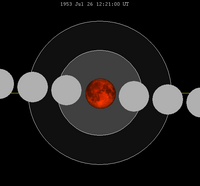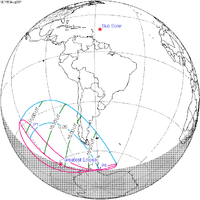|
July 1953 lunar eclipse
A total lunar eclipse occurred at the Moon’s ascending node of orbit on Sunday, July 26, 1953,[1] with an umbral magnitude of 1.8629. It was a central lunar eclipse, in which part of the Moon passed through the center of the Earth's shadow. A lunar eclipse occurs when the Moon moves into the Earth's shadow, causing the Moon to be darkened. A total lunar eclipse occurs when the Moon's near side entirely passes into the Earth's umbral shadow. Unlike a solar eclipse, which can only be viewed from a relatively small area of the world, a lunar eclipse may be viewed from anywhere on the night side of Earth. A total lunar eclipse can last up to nearly two hours, while a total solar eclipse lasts only a few minutes at any given place, because the Moon's shadow is smaller. Occurring about 2.1 days before perigee (on July 28, 1953, at 14:45 UTC), the Moon's apparent diameter was larger.[2] With an umbral lunar eclipse magnitude of 1.8629, this was the largest lunar eclipse of the 20th century. Gamma had a value of only −0.0071. Due to the Moon's relatively large size, totality lasted 100 minutes and 42 seconds unlike July 16, 2000, which lasted 106 minutes and 25 seconds, the longest since August 13, 1859 (which was only 3 seconds longer). This was the darkest total lunar eclipse in the 20th century. VisibilityThe eclipse was completely visible over Australia, Antarctica, and much of the Pacific Ocean, seen rising over much of Asia and setting over North and South America.[3]
Eclipse detailsShown below is a table displaying details about this particular solar eclipse. It describes various parameters pertaining to this eclipse.[4]
Eclipse seasonThis eclipse is part of an eclipse season, a period, roughly every six months, when eclipses occur. Only two (or occasionally three) eclipse seasons occur each year, and each season lasts about 35 days and repeats just short of six months (173 days) later; thus two full eclipse seasons always occur each year. Either two or three eclipses happen each eclipse season. In the sequence below, each eclipse is separated by a fortnight.
Related eclipsesEclipses in 1953
Metonic
Tzolkinex
Half-Saros
Tritos
Lunar Saros 128
Inex
Triad
Lunar eclipses of 1951–1955This eclipse is a member of a semester series. An eclipse in a semester series of lunar eclipses repeats approximately every 177 days and 4 hours (a semester) at alternating nodes of the Moon's orbit.[5] The penumbral lunar eclipses on March 23, 1951 and September 15, 1951 occur in the previous lunar year eclipse set, and the lunar eclipses on June 5, 1955 (penumbral) and November 29, 1955 (partial) occur in the next lunar year eclipse set.
Saros 128Lunar saros series 128, repeating every 18 years and 11 days, has a total of 71 lunar eclipse events including 57 umbral eclipses (42 partial lunar eclipses and 15 total lunar eclipses). Solar Saros 135 interleaves with this lunar saros with an event occurring every 9 years 5 days alternating between each saros series.
Lunar Saros 128 contains 15 total lunar eclipses between 1845 and 2097 (in years 1845, 1863, 1881, 1899, 1917, 1935, 1953, 1971, 1989, 2007, 2025, 2043, 2061, 2079 and 2097). Solar Saros 135 interleaves with this lunar saros with an event occurring every 9 years 5 days alternating between each saros series. Inex seriesThe inex series repeats eclipses 20 days short of 29 years, repeating on average every 10571.95 days. This period is equal to 358 lunations (synodic months) and 388.5 draconic months. Saros series increment by one on successive Inex events and repeat at alternate ascending and descending lunar nodes. This period is 383.6734 anomalistic months (the period of the Moon's elliptical orbital precession). Despite the average 0.05 time-of-day shift between subsequent events, the variation of the Moon in its elliptical orbit at each event causes the actual eclipse time to vary significantly. It is a part of Lunar Inex series 39. All events in this series listed below and more are total lunar eclipses.
Half-Saros cycleA lunar eclipse will be preceded and followed by solar eclipses by 9 years and 5.5 days (a half saros).[7] This lunar eclipse is related to two annular solar eclipses of Solar Saros 135.
See alsoNotes
External links
References
|
||||||||||||||||||||||||||||||||||||||||||||||||||||||||||||||||||||||||||||||||||||||||||||||||||||||||||||||||||||||||||||||||||||||||||||||||||||||||||||||||||||||||||||||||||||||||||||||||||||||||||||||||||||||||||||||||||||||||||||||||||||||||||||||||||||||||||||||||||||||||||||||||||||||||||||||||||||||||||||||||||||||||






















































